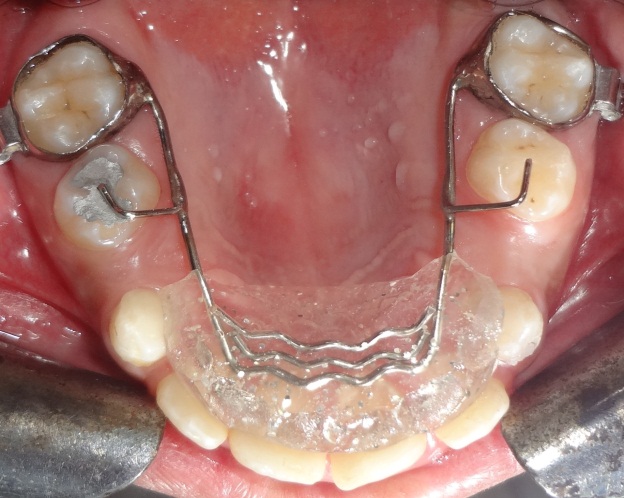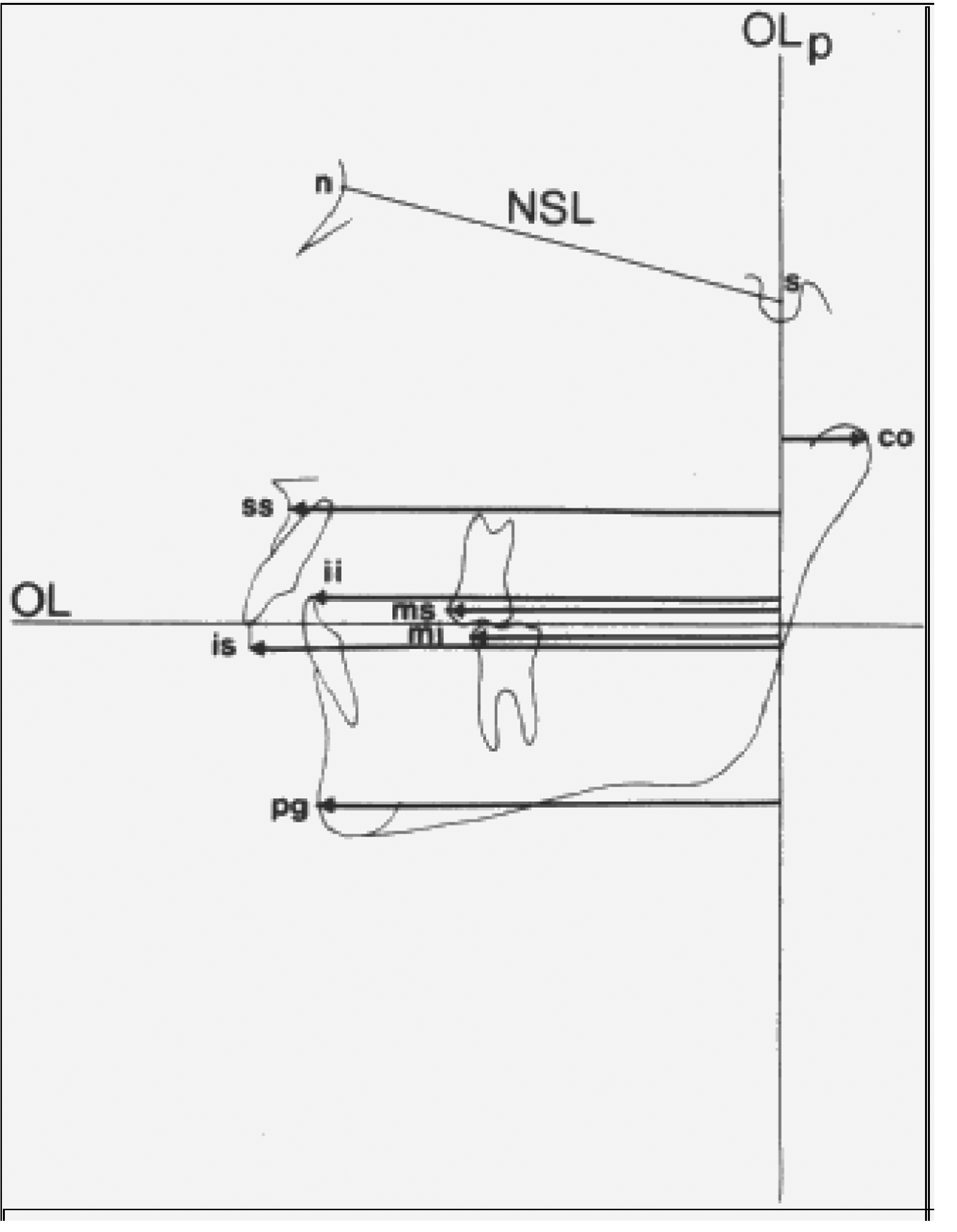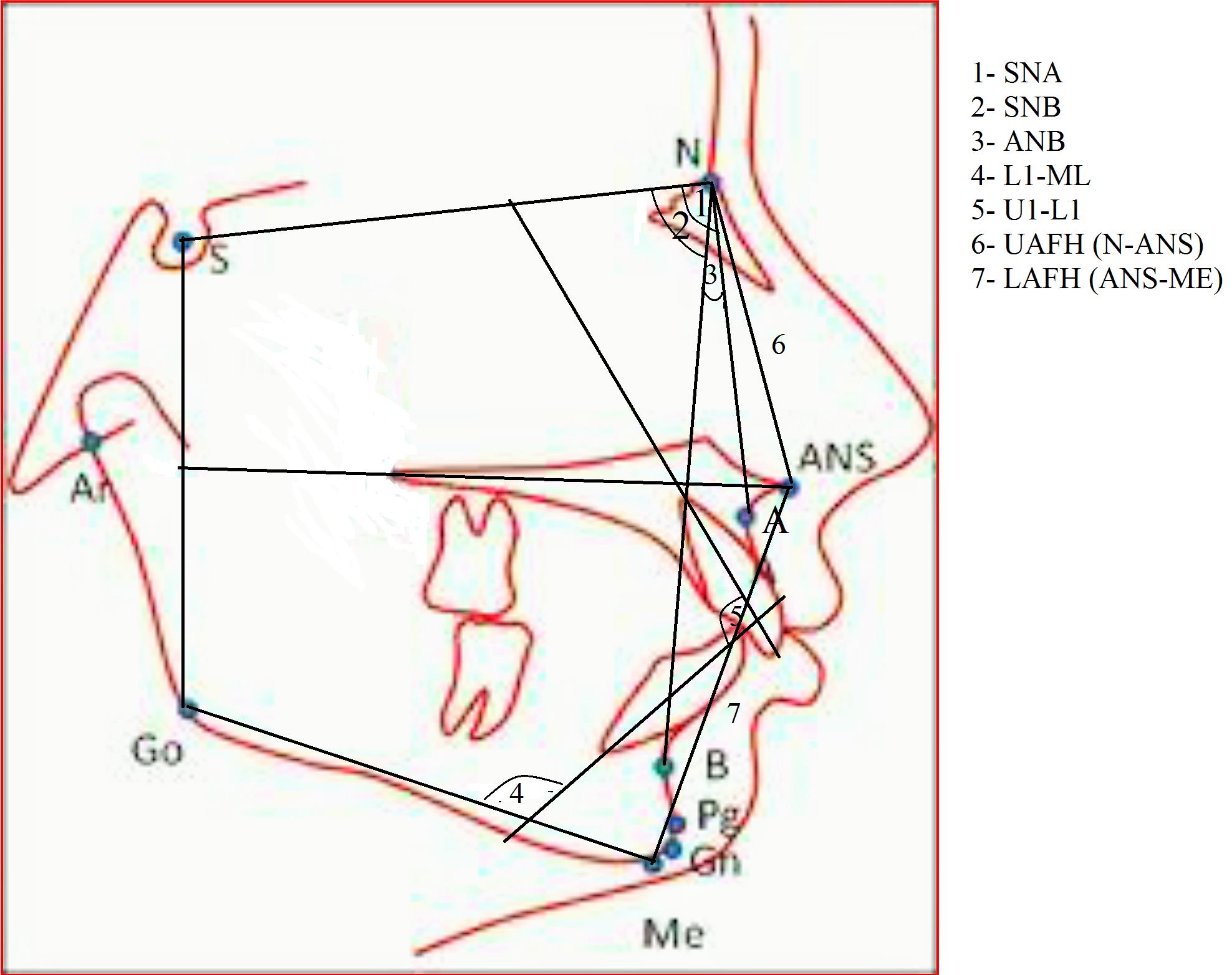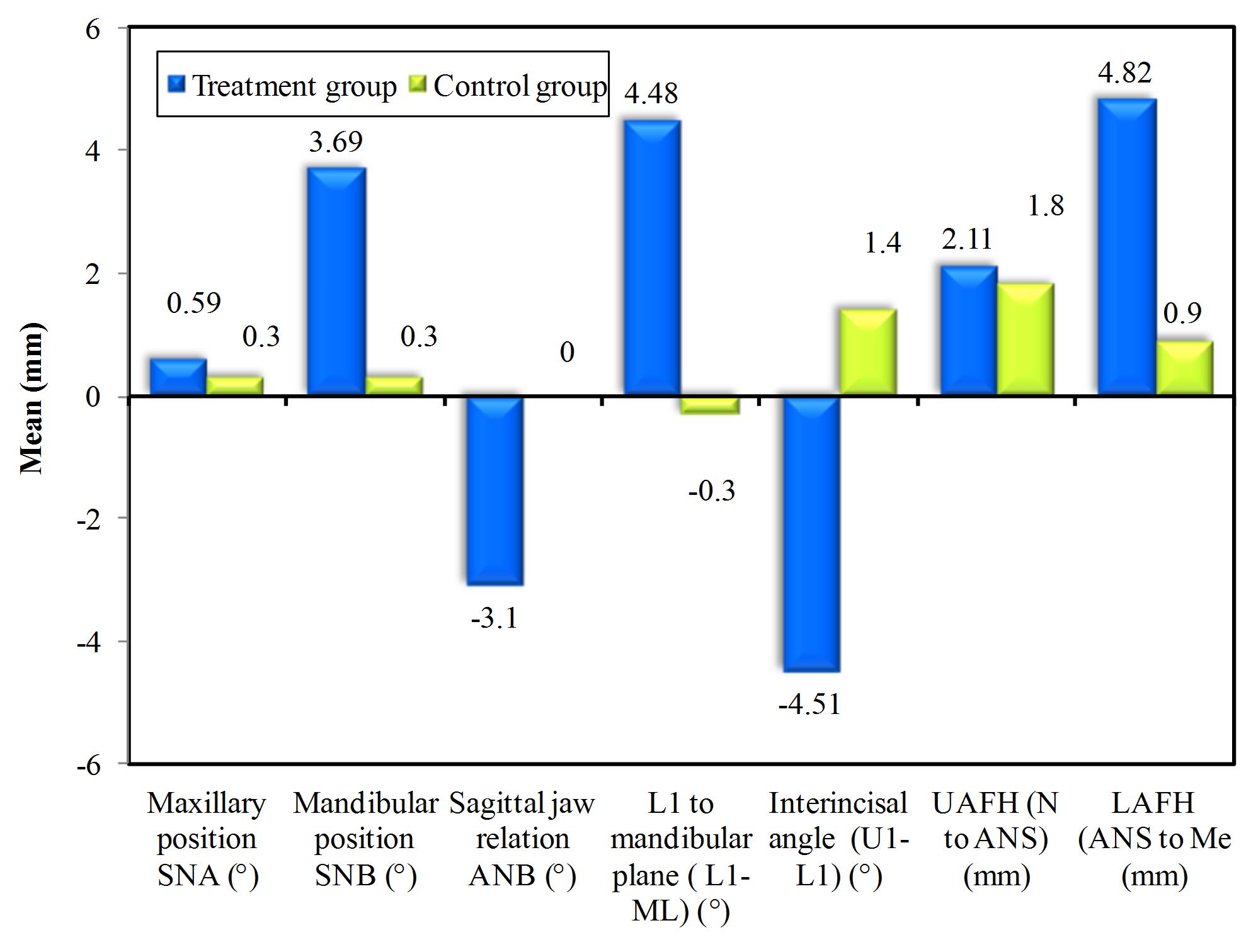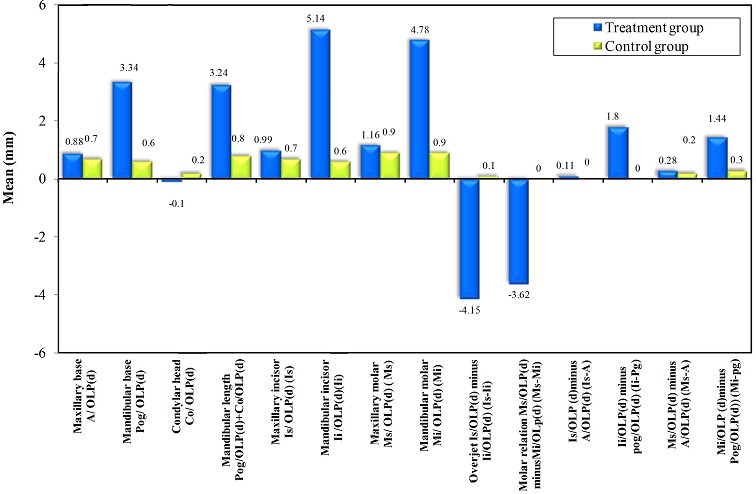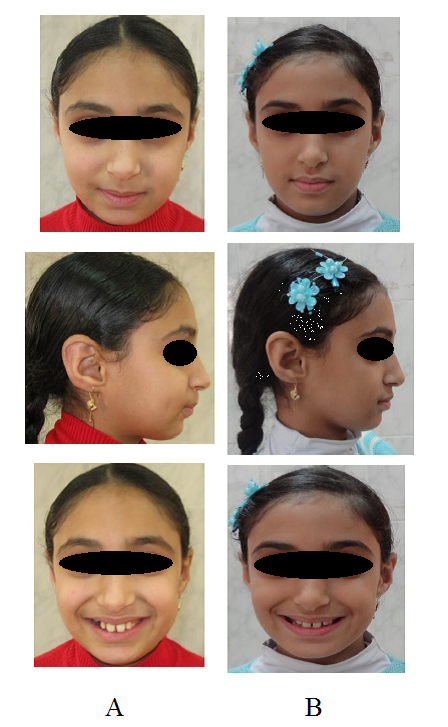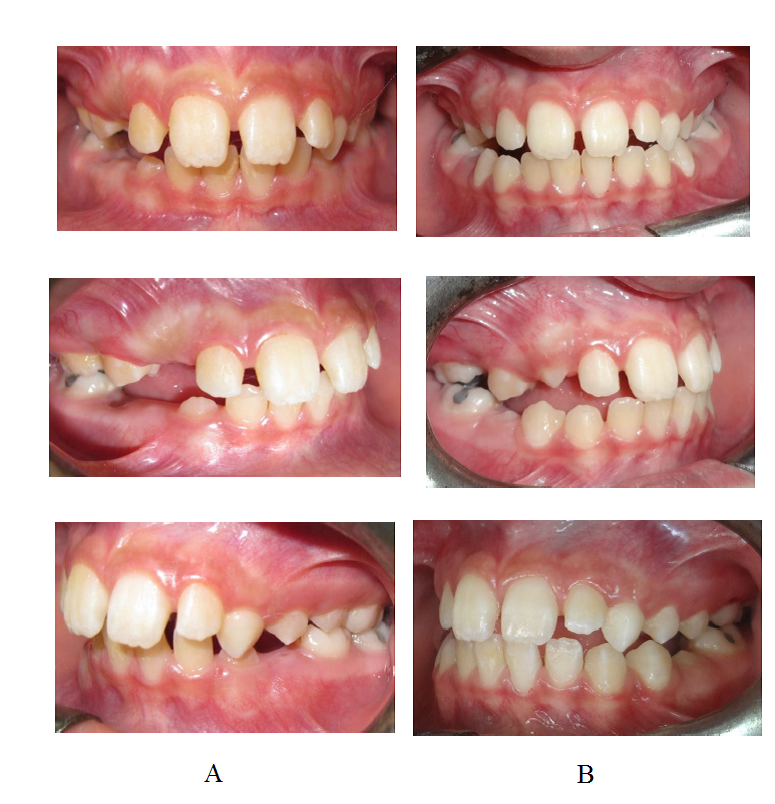Skeletal and Dento-Alveolar effects of the Rick-A-Nator Appliance in Early Stage Correction of Class II Malocclusion
Shaza M. Hammad*, Sahar M. Ahmed, Ahmed M. Hafez
Affiliation
Department of Orthodontics, Faculty of Dentistry, Mansoura University, Egypt
Corresponding Author
Shaza M. Hammad, Associate Professor, Department of Orthodontics, Faculty of Dentistry, Mansoura University, Egypt, E-mail: shazamohammad@yahoo.com
Citation
Hammad, S.M., et al. Skeletal and Dento-Alveola Reffects of the Rick-A-Nator Appliance in Early Stage Correction of Class II Malocclusion. (2016) J Dent Oral Care 2(3): 1- 8.
Copy rights
© 2016 Hammad, S.M. This is an Open access article distributed under the terms of Creative Commons Attribution 4.0 International License.
Keywords
Skeletal and dentoalveolareffects, Rick-A-Nator appliance, Class II malocclusion, retrusive mandible
Abstract
Aim: The aim of the present study was to evaluate the skeletal and dento-alveolar effects of the Rick-A-Nator appliance in the treatment of growing patients with skeletal Class II malocclusion due to retrusive mandible.
Methods: 13 Class II growing patients with mandibular retrusion and between the ages of 9 years and 12 years were selected to be included in this study. Control group for the treated group was generated from growth data of untreated Class II subjects. Pre-treatment and post-treatment lateral cephalometric radiographs were traced and analyzed. Changes in the treated group were compared to those in the control group.
Results: The mandibular length was highly significantly increased by 2.44 mm. The mandibular incisors were proclined by distance of 4.54 mm. The overjet was highly significantly reduced by 4.25 mm. The molar relation was significantly corrected by 3.62 mm. While the overbite was reduced from a mean of 75.43% before treatment to a mean of 21.16% after treatment.
Conclusions: The Rick-A-Nator appliance was effective in treatment of Class II malocclusion with deficient mandible. Significant reduction of the overjet and the overbite were associated with the Rick-A-Nator treatment.
Introduction
Class II malocclusion is the most common problem in orthodontic practice which represents one-third of the population. It has various skeletal and dental configurations[1]. Mc Namara concluded that the most common single characteristic of class II malocclusions is a deficiency in the anteroposterior position of the mandible rather than maxillary prognathism[2]. Consequently a treatment approach aiming at mandibular growth modification and redirection is indicated in this patients[3].
A wide range of removable and fixed functional appliances have been developed. These appliances aimed to induce forward growth of the mandible by anterior positioning of it and forcing the patient to function with lower jaw forward[1]. The removable functional appliances demand patient cooperation for the success of the treatment; tend to be bulky and take some time to get used to. Consequently, the fixed functional appliances have been introduced to overcome disadvantages of removable functional appliances[4]. They are effective without depending on patient’s collaboration and multi-bracket therapy can be used; hence the treatment time is shorter[5,6].
The Rick-A-Nator is a fixed functional appliance. It is introduced as an alternative to removable functional appliances. It is claimed to be an effective functional appliance that treat mandibular and vertical deficiencies. The main advantage of the Rick-A-Nator appliance is its independence on patient cooperation. It is also compact and less bulky; this improves patient comfort and speech. In addition, it is virtually invisible, which increase patient acceptance[7].
The Rick-A-Nator (Figure 1) consists of two molar bands on the upper first permanent molars and an anterior acrylic bite plate which is fabricated from self-cure acrylic resin. This anterior bite plane is converted into an anterior repositioning appliance by the addition of acrylic incisal ramp. The acrylic incisal ramp engages the lingual of the anterior teeth and so, the lower teeth bite into a forward bite relationship. The anterior inclined plane guides the mandible forward into a class I relationship as the patient closes. The anterior acrylic is connected to the molar bands by 0.045 stainless steel connector wires. Rests can be added on primary molars or first bicuspids to increase the stability of the appliance[7]. Up till now, there is no sufficient studies regarding the effects of this appliance. So, the aim of this study was to investigate the possible effects of the Rick-A-Nator appliance in the treatment of Class II malocclusion.
Figure 1: Rick-A-Nator appliance design.
Materials and Methods
A sample of 13 Class II mandibular retrusive patients were selected from the outpatient clinic of the Orthodontic Department, Faculty of Dentistry, Mansoura University, Egypt. The study started with 13 patients and ended with 10 patients. Informed consents were obtained from all the patients and their parents. The inclusion criteria were:
• Growing individuals with an age range of 9 - 12 years old.
• Patients with skeletal class II malocclusion.
• Patients with mandibular retrusion.
• Normal or deep bite.
• Patients were in the mixed dentition
• No previous orthodontic treatment.
• Good oral hygiene.
• No abnormal oral habits.
• No systemic disease.
Growth data of untreated Class II subjects[8] and the control group of previous study[9] were used to generate control group for the treatment group of this study. The use of historical controls was due to the lack of ethical reasons to leave Class II patients untreated at the developmental period that is known to represent the optimal time for orthopaedic modifications[10,11].
As the favorable response of the mandible depend on skeletal maturation age of the patient, hand wrist radiographs were taken for all patients before treatment to assess the skeletal age. Lateral cephalometric radiographs, photographs and dental casts were also taken for all patients before and after the treatment period. Linear cephalometric analysis (Figure 2) was carried out according to Pancherz’s linear analysis[9]. In this analysis, the same references lines; OL (Occlusalplane) and OLP (a line perpendicular to OL through S), were used before and after treatment. Other vertical and angular cephalometric measurements were also assessed (Figure 3).
Figure 2: Measuring points and lines used in the linear cephalometric analysis. The registration line (NSL) and reference lines (OL and OLp) are shown.
Figure 3: Angular and vertical cephalometric measurements.
Rick-A-Nator appliance was fabricated for each patient. Elastic separators were first placed mesial to the maxillary first permanent molars and were removed after 1 week. Two upper molar bands were then fitted and upper and lower impressions were taken. The patient was asked for positioning of the mandible in the desired forward position where the skeletal midlines were properly aligned and then the wax bite was taken. Working models with the two maxillary molar bands were poured in white stone and used with the wax bite to construct the Rick-A-Nator appliance.
Statistical Analysis
All subjects were treated with Rick-A-Nator appliance for a treatment period of one year. Data were fed to the computer and analyzed using IBM SPSS software package version 20.0. Quantitative data were described using mean and standard deviation for normally distributed data. Comparison between treatment and control groups were done using Paired-t-test. Significance of the obtained results was judged at the 5% level.
Method Error
All cephalograms were traced and superimposed by the same operator and were checked by a second operator to verify anatomical outlines, landmark placement, and tracing superimpositions. Any disagreements were resolved to the satisfaction of both observers.
Results
Rick-A-Nator appliance resulted in significant skeletal changes in the mandible. Stimulation of forward growth of the mandible was evidenced by the highly significantly increased SNB angle (3.39°) (P < 0.001). Significant anterior shift of the pogonion point (Pog/OLP) (2.74 mm) and a highly significant increase in the mandibular length were also revealed (2.44 mm). On the other hand, non-significant changes occurred in the maxillary skeletal values; (A/OLP) length and SNA angle were (0.18 mm & 0.29° respectively) (Table 1; Figure 4 & Table 2; Figure 5).
Table 1: Angular and vertical cephalometric changes in treatment and control groups.
| Measurements (m) | Treatment group | Control group | Statistical comparisons | ||||
|---|---|---|---|---|---|---|---|
| Mean | SD | Mean | SD | Group difference (Treatment effect) | p | Significance | |
| Maxillary position SNA (°) | 0.59 | 0.14 | 0.3 | 0.9 | 0.29 | 0.163 | NS |
| Mandibular position SNB (°) | 3.69 | 0.92 | 0.3 | 1 | 3.39 | < 0.001** | Highly Sig. |
| Sagittal jaw relation ANB (°) | -3.1 | 0.76 | 0 | 0.7 | -3.1 | < 0.001** | Highly Sig. |
| L1 to mandibular plane( L1-ML)(°) | 4.48 | 1.1 | -0.3 | 1.7 | 4.78 | < 0.001** | Highly Sig. |
| Interincisal angle (U1-L1)(°) | -4.51 | 1.1 | 1.4 | 3.2 | -5.91 | < 0.001** | Highly Sig. |
| UAFH (N to ANS) (mm) | 2.11 | 0.52 | 1.8 | 1 | 0.31 | 0.226 | NS |
| LAFH (ANS to Me (mm) | 4.82 | 1.2 | 0.9 | 1 | 3.92 | < 0.001** | Highly Sig. |
Figure 4: Angular and vertical cephalometric changes in treatment and control groups.
Table 2: Linear cephalometric changes in treatment and control groups.
| Measurements (m) | Treatment group | Control group | Statistical comparisons | ||||
|---|---|---|---|---|---|---|---|
| Mean | SD | Mean | SD | Group difference (Treatment effect) | p | Significance | |
| Maxillary base A/ OLP(d) | 0.88 | ± 1.21 | 0.7 | 0.6 | 0.18 | 0.555 | NS |
| Mandibular base Pog/ OLP(d) | 3.34 | ± 0.88 | 0.6 | 0.7 | 2.74 | < 0.001** | Highly Sig. |
| Condylar head Co/ OLP(d) | -0.1 | ± 0.52 | 0.2 | 0.5 | -0.3 | 0.070 | NS |
| Mandibular length Pog/OLP(d) + Co/OLP(d) | 3.24 | ± 0.92 | 0.8 | 0.7 | 2.44 | < 0.001** | Highly Sig. |
| Maxillary incisor Is/ OLP(d) (Is) | 0.99 | ± 1.21 | 0.7 | 0.3 | 0.29 | 0.305 | NS |
| Mandibular incisor Ii /OLP(d)(Ii) | 5.14 | ± 1.57 | 0.6 | 0.2 | 4.54 | < 0.001** | Highly Sig. |
| Maxillary molar Ms/ OLP(d) ( Ms) | 1.16 | ± 0.42 | 0.9 | 0.5 | 0.26 | 0.083 | NS |
| Mandibular molar Mi/ OLP(d) (Mi) | 4.78 | ± 1.04 | 0.9 | 0.4 | 3.88 | < 0.001** | Highly Sig. |
| Overjet Is/OLP(d) minus Ii/OLP(d) (Is-Ii) | -4.15 | ± 0.75 | 0.1 | 0.4 | -4.25 | < 0.001** | Highly Sig. |
| Molar relation Ms/OLP(d) minusMi/OLp(d) (Ms-Mi) | -3.62 | ± 0.90 | 0 | 0.2 | -3.62 | < 0.001** | Highly Sig. |
| Is/OLP (d)minus A/OLP(d) (Is-A) | 0.11 | ± 0.34 | 0 | 0.4 | 0.11 | 0.355 | NS |
| Ii/OLP(d) minus pog/OLP(d) (Ii-Pg) | 1.8 | ± 0.95 | 0 | 0.4 | 1.8 | < 0.001** | Highly Sig. |
| Ms/OLP(d) minus A/OLP(d) (Ms-A) | 0.28 | ± 1.33 | 0.2 | 0.8 | 0.08 | 0.819 | NS |
| Mi/OLP (d)minusPog/OLP(d)) (Mi-pg) | 1.44 | ± 1.23 | 0.3 | 0.5 | 1.14 | 0.001** | Highly Sig. |
Figure 5: Linear cephalometric changes in treatment and control groups.
Additionally, the sagittal intermaxilly relationship improved by highly statistically and clinically significant decrease of ANB angle (-3.1°) (P < 0.001). The lower anterior facial height (LAFH) was highly significantly increased (3.92 mm) (P < 0.001).
Regarding the effects of Rick-A-Nator appliance on mandibular incisors position, there was a highly significant proclination of mandibular incisors as L1-ML angle and (Ii /OLP) length were highly significantly increased (4.78° & 4.54 mm respectively) (P < 0.001). However a minimal and non-significant proclination of maxillary incisors was observed as (Is/OLP) length was not significantly increased (0.29 mm) (p > 0.05). The interincisal angle was highly significantly decreased (-5.91°). The overjet (Is-Ii) and the overbite were highly significantly reduced (Figure 6, 7). The overbite decreased from a mean of 75.43% before treatment to a mean of 21.16% after treatment (P < 0.001).
Figure 6: A, pre-treatment extra-oral photographs; B, post-treatment extra-oral photographs.
Figure 7: A, pre-treatment intra-oral photograph; B, post-treatment intra-oral photographs.
After treatment, non-significant change in the position of the maxillary molars (Ms) was found (0.26 mm). On the other hand, the mandibular molars (Mi) drifted mesially by a highly significant distance (Mi/OLP) (3.88 mm) (P < 0.001) and the molar relation (Ms-Mi) was highly significantly corrected (-3.62 mm) (P < 0.001).
Discussion
Class II malocclusions are characterized by certain dental and/or skeletal characteristics. These characteristics are usually expressed with each other, but to different extents. The dental component is characterized as distal relationship of mandibular teeth relative to maxillary teeth. The skeletal component is characterized as anteroposterior disproportion of the two jaws relative to each other. This disproportion is usually due to mandibular retrusion[12]. In growing patient, growth modification by functional appliances is a well-known strategy to reduce mandibular retrognathism by accelerating the development of the mandible[13]. Many functional appliances are available for achieving this, but clinicians usually seek for simple and effective ones. This study was conducted to thoroughly evaluate the effect of Rick-A-Nator which is a fixed functional appliance in the treatment of Class II malocclusion due to retruded mandible.
During treatment with Rick-A-Nator appliance, the patient had to move the mandible forward to engage the appliance. This induced adaptive reaction to the new pattern of mandibular closure and resulted in an increase of the forward growth of the mandible. This increase was evident by the highly significant increase in the SNB angle. These findings were similar to that obtained with other functional appliances studies[14-18] but in contrast to the results of Lux, et al. and Jonson et al[19,20].
The significant increase in the forward position of the mandible (Pog/OLP) after Rick-A-Nator appliance treatment was mainly due to a highly significant increase in the length of the mandible (Pog/OLP and CO/OLP), which was thought to be a result of the stimulation of condylar growth. The forward mandibular displacement causes the elongation and stretching of the muscle fibers and tendons which in turn lead to the pull of the muscular attachments at the bone surface. This action induces bone remodeling processes[21]. So, the mandible as a whole was also somewhat displaced forward by Rick-A-Nator appliance treatment. This anterior displacement might be a result of remodeling processes in the articular fossa or due to a functional adaptation in mandibular position. These significant findings were in accordance with most of other studies[9,15,22]. However, non-significant findings were found by Stromeyer[23]. The difference in the finding might be attributed to the fact that his patients were not close enough to pubertal growth peak.
The use of Rick-A-Nator appliance in the treatment of Class II malocclusion appeared to have no restraining effect on the forward growth of the maxilla. This was evident by the slight non-significant increase in both SNA angle and maxillary jaw base length (A/OLP). This result was in agreement with previous functional appliance study[14]. However, opposite results were reported in other studies[15-17]. This controversy might be due to the difference in the appliance designs, as the Rick-A-Nator appliance was not designed to block the forward growth of the maxilla.
The sagittal maxillo-mandibular relationship was also improved after treatment with the Rick-A-Nator appliance. This improvement was evidenced by a highly significant decrease of ANB angle with mean of (-3.1°). The significant reduction of ANB angle was mainly due to a highly significant increase in SNB angle; due to forward mandibular growth by Rick-A-Nator appliance. This result was similar to most of other previous studies[14,17,24]. However, dissimilar outcome was obvious in the findings of Tumar, et al.[25] who detected no significant change in ANB angle when using Mini-Block appliance. This might be due to non-compliance of their patients.
The treatment with the Rick-A-Nator appliance resulted also in a significant increase in the lower anterior facial height (ANS-Me). This could be attributed to the increase of the mandibular ramus height and extrusion of lower first permanent molars because the appliance design allowed the opening of the bite posteriorly leading to passive extrusion of lower first permanent molars in approximately 3 months. These results were in agreement with many previous studies[18,26]. On the other hand, these findings were in disagreement with the findings of Van Laecken, et al. and Sari, et al.[15,27]
Regarding the maxillary incisor position, there was a lack of significant differences in the inclination of maxillary incisors (Is/OLP) and (Is-A) with Rick-A-Nator appliance treatment. This result was similar to finding of previous studies[9,28] but, dissimilar findings were found in other studies[15-17]. On the other hand, there was a highly significant proclination of the lower incisors as the lower incisor mandibular plane angle (L1-ML), mandibular incisor position (Ii/OLP) and (Ii-Pog) were highly significantly increased after the Rick-A-Nator appliance treatment. This proclination could be explained to the resultant mesial force on the mandibular incisors produced by incisal ramp of the Rick-A-Nator appliance. This result was in accordance to other previous functional appliances studies[15,17]. However, less incisal proclination was reported by Windmiller and Sidhu, et al.[29,30] when using bonded Herbst appliance. This may be attributed to the use of splint which covered the incisal third of the mandibular anterior teeth.
Based on the findings of this study, the interincisal angle was decreased significantly after treatment. This could be attributed to a highly significant proclination of lower incisors and non-significant difference of the inclination of the upper incisors. This outcome was in agreement with those of Van Laecken, et al.[15] and Lund, et al.[31] However, it differed from those of Weiland, et al.[16], Trenouth.[17] and Sari, et al.[27]
This study showed a highly significant reduction in the overjet as evidenced from the cephalometric analysis, (Is-Ii). This reduction in the over jet was a highly significant result after the treatment period with a mean of (-4.25 mm), which could be due to both skeletal and dental changes. This reduction in the overjet was a constant finding with all other functional appliances[14-16,24,31].
The Rick-A-Nator appliance had a beneficial effect in the treatment of deep bite as evidenced from the dental cast analysis. The overbite was highly significantly reduced from a mean of 75.43% before treatment to a mean of 21.16% after treatment. This reduction was mainly due to increase in the mandibular ramus height, extrusion of lower first permanent molars and the proclination of mandibular incisors. This was in accordance with previous studies[14-17,32]. However, this was in difference with studies of Windmiller and sidhu, et al.[29,30] who reported that the reduction of the overbite was mainly attributed to the intrusion of lower incisors.
Regarding the position of lower molars, Rick-A-Nator appliance treatment resulted in a highly significant change in the position of the lower molars (Mi/OLP) as they drifted mesially with a mean of (3.88 mm). This could be attributed to forward man dibular advancement and mandibluar incisors proclination. This finding was similar to findings of Herbst therapy with range of 2.1 - 5.1 mm molar mesial drift. Other previous studies showed also the same effect[23,32].
In the present study, there was a non-significant change in the position of the upper molars (Ms/OLP) and (Ms-A). Interestingly, there was no significant distal movement of the upper molars; they almost remained at the same position. Many studies reported different degrees of upper molar distalization[6,9,23]. This difference might be due to the difference in the appliance designs. However, maxillary and mandibular molars relationship was improved as the (Ms-Mi) was highly significantly decreased due to the mesial drift of the lower molars. This finding was in accordance with that of other fixed functional studies[6,9,23,32].
Conclusion
Based on the results of this study, the following conclusions can be obtained:
1) The Rick-A-Nator appliance is an effective way to treat class II malocclusion with deficient mandible.
2) Skeletal effects of The Rick-A-Nator appliance include: stimulation of the forward growth of the mandible, statistically and clinically significant increase in the total length of the mandible and in ramus height.
3) The Rick-A-Nator appliance had its greatest dental effects on the mandibular incisors and molars as it caused significant proclination of the lower incisors and significant mesial drift of the lower molar. However, it had non-significant effect on the maxillary incisors and molars.
4) Significant improvement of the overbite occurred with the Rick-A-Nator appliance.
References
- 1. Cozza, P., Baccetti, T., Franchi, L., et al. Mandibular changes produced by functional appliances in Class II malocclusion: a systematic review. (2006) Am J Orthod Dentofacial Orthop 129(5): 599.e1-12.
- 2. Mc Namara, J.A. Components of Class II malocclusion in children 8-10 years of age. (1981) Angle Orthod 51(3): 177-202.
- 3. Küçükkeles, N., ?lhan, I., Orgun, ?.A. Treatment Efficiency in Skeletal Class II Patients Treated with the Jasper Jumper: A Cephalometric Evaluation. (2007) Angle Orthod 77(3): 449-456.
- 4. Franchi, L., Alvetro, L., Giuntini, V., et al. Effectiveness of comprehensive fixed appliance treatment used with the Forsus Fatigue Resistant Device in Class II patients. (2011) Angle Orthod 81(4): 678-683.
- 5. Pancherz, H., Littmann, C. Morphology and position of the mandible in the autumn Treatment. cephalometric analysis of changes to the growth graduation. (1989) Inf Orthod Kieferorthop 21(4): 493-513.
- 6. Heinig, N., Göz, G. Clinical Application and Effects of the Forsus™ Spring A Study of a New Herbst Hybrid. (2001) J Orofac Orthop 62(6): 436-450.
- 7. Rondeau, B.H. Rick-A-Nator appliance. (1992) J Gen Orthod 3(1): 16-20.
- 8. Stahl, F., Baccetti, T., Franchi, L., et al. Longitudinal growth changes in untreated subjects with Class II division 1 malocclusion. (2008) Am J Orthod Dentofacial Orthop 134(1): 125-137.
- 9. Pancherz H. The mechanism of Class II correction in Herbst appliance treatment: a cephalometric investigation. (1982) Am J Orthod 82(2): 104-113.
- 10. Baccetti, T., Franchi, L., Toth, L.R., et al. Treatment timing for twin-block therapy. (2000) Am J Orthod Dentofacial Orthop 118(2): 159-170.
- 11. Baccetti, T., Franchi, L., Stahl, F. Comparison of 2 comprehensive Class II treatment protocols including the bonded Herbst and headgear appliances: a double-blind study of consecutively treated patients at puberty. (2009b) Am J Orthod Dentofacial Orthop 135(6): 698e1–698e10.
- 12. Bishara, S.E. Class II malocclusions: diagnostic and clinical considerations with and without treatment Seminars in Orthodontics. (2006) Elsevier 12(1): 11-24.
- 13. Pachori, Y., Navlani, M., Gaur, T., et al. Treatment of skeletal class II division 1 malocclusion with mandibular deficiency using myofunctional appliances in growing individuals. (2012) J Indian Soc Pedod Prev Dent 30(1): 56-65.
- 14. Freeman, D.C., McNamara, J.A., Baccetti, T., et al. Long-term treatment effectsof the FR-2 appliance of Fränkel. (2009) Am J Orthod Dentofacial Orthop 135(5): 570.e1-6.
- 15. VanLaecken, R., Martin, C.A., Dischinger, T., et al. Treatment effects of the edgewise Herbst appliance: a cephalometric and tomographic investigation. (2006) Am J Orthod Dentofacial Orthop 130(5): 582-593.
- 16. Weiland, F.J., Bantleon, H.P. Treatment of Class II malocclusions with the Jasper Jumper appliance—a preliminary report. (1995) Am J Orthod Dentofacial Orthop 108(4): 341-350.
- 17. Trenouth, M.J. Cephalometric evaluation of the Twin-block appliance in the treatment of Class II Division 1 malocclusion with matched normative growth data. (2000) Am J Orthod Dentofacial Orthop 117(1): 54-59.
- 18. Faltin K,J., Faltin, R.M., Baccetti, T., et al. Long-term effectiveness and treatment timing for bionator therapy. (2003) Angle Orthod 73(3): 221-230.
- 19. Lux, C.J., Rübel, J., Starke, J., et al. Effects of early activator treatment in patients with Class II malocclusion evaluated by thin-plate spline analysis. (2001) Angle Orthod 71(2): 120-126.
- 20. Janson, G., Caffer Dde, C., Henriques, J.F.C., et al. Stability of Class II, division 1 treatment with the headgear-activator combination followed by the edgewise appliance. (2004) Angle Orthod 74(5): 594-604.
- 21. Pancherz, H. The Herbst appliance-its biologic effects and clinical use. (1985) Am J Orthod 87(1): 1-20.
- 22. Karacay, S., Akin, E., Olmez, H., et al. Forsus nitinol flat spring and Jasper Jumper corrections of Class II division 1 malocclusions. (2006) Angle Orthod 76(4): 666-672.
- 23. Stromeyer, E.L., Caruso, J.M., DeVincenzo, J.P. A cephalometric study of the Class II correction effects of the Eureka Spring. (2002) Angle Orthod 72(3): 203-210.
- 24. de Almeida, M.R., Henriques, J.F., de Almeida, R.R., et al. Short-term treatment effects producedby the Herbst appliance in the mixed dentition. (2005) Angle Orthod 75(4): 540-547.
- 25. Tümer, N., Gültan, A.S. Comparison of the effects of monoblock and twin-block appliances on the skeletal and dentoalveolar structures. (1999) Am J Orthod Dentofacial Orthop 116(4): 460-468.
- 26. Ahn, S.J., Kim, J.T., Nahm, D.S. Cephalometric markers to consider in the treatment of Class II Division 1 malocclusion with the bionator. (2001) Am J Orthod Dentofacial Orthop 119(6): 578-586.
- 27. Sari, Z., Goyenc, Y., Doruk, C., et al. Comparative evaluation of a new removable Jasper Jumper functional appliance vs an activator-headgear combination. (2003) Angle Orthod 73(3): 286-293.
- 28. Pancherz, H. Treatment of Class II malocclusions by jumping the bite with the Herbst appliance: a cephalometric investigation. (1979) Am J Orthod 76(4): 423-442.
- 29. Windmiller, E.C. The acrylic-splint Herbst appliance: a cephalometric evaluation. Am J Orthod Dentofacial Orthop 104(1): 73-84.
- 30. Sidhu, M., Kharbanda, O., Sidhu, S. Cephalometric analysis of changes produced by a modified Herbst appliance in the treatment of Class II division 1 malocclusion. (1995) Brit J Orthod 22(1): 1-12.
- 31. Lund, D.I., Sandler, P.J. The effects of Twin Blocks: a prospective controlled study. (1998) Am J Orthod Dentofacial Orthop 113(1): 104-110.
- 32. Nakhleh. Multi bracket appliance treatment for non compliant class II patient, a clinical study. (2007) University of Modena-SIDO congress Napoli/Italy.


